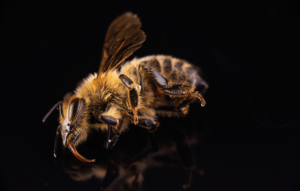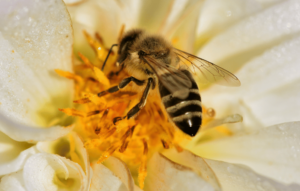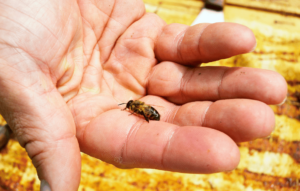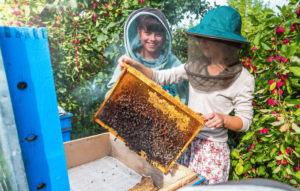 With each passing year, we are increasingly intertwining technology into our environment – as a result, electromagnetic fields (EMFs) are now an unavoidable part of modern life. From the power lines that run through our neighborhoods to the Wi-Fi networks that keep us connected to the world, EMFs are constantly present in our environment. While these invisible forces make our technology work, a growing body of research suggests they may also be doing something else — disrupting biological systems (including us).
With each passing year, we are increasingly intertwining technology into our environment – as a result, electromagnetic fields (EMFs) are now an unavoidable part of modern life. From the power lines that run through our neighborhoods to the Wi-Fi networks that keep us connected to the world, EMFs are constantly present in our environment. While these invisible forces make our technology work, a growing body of research suggests they may also be doing something else — disrupting biological systems (including us).
Among those most affected are honeybees, the tiny but diligent pollinators that our food supply heavily depends on. Recent studies have revealed that EMFs are disrupting the bees’ ability to navigate, forage, and ultimately survive. These findings don’t just spell trouble for honeybees; they have serious implications for the entire ecosystem, including us. What happens to bees when they encounter EMFs could make us rethink our reliance on these technologies.
Let’s explore the latest research to understand how EMFs are impacting honeybees and what this might mean for the future of our environment — and our own well-being.
How EMFs Are Stressing Out Honeybees
The effects of electromagnetic fields (EMFs) on humans are often glossed over, though that is starting to change, but for honeybees, they represent a serious threat. Recent research has shown that exposure to EMFs triggers stress responses in honeybees, affecting both their physiology and behavior in troubling ways. One of the most telling signs of stress is the increased production of heat-shock proteins and other markers that bees produce when under duress. These stress markers are not just a sign of minor discomfort — they indicate that honeybees are undergoing significant physiological strain.
The effects of EMFs also go beyond internal stress though. Honeybees rely on a finely tuned sense of magnetoreception to navigate their environment, find food sources, and return to their hives. EMFs, especially those from artificial sources like power lines and cell towers, interfere with these natural navigation systems. This leads to disorientation, impaired foraging behavior, and in some cases, bees failing to return to their colonies at all. These disruptions can have serious consequences, potentially contributing to phenomena like colony collapse disorder.
What’s even more concerning is that these behavioral changes reduce the frequency of honeybee visits to flowers, directly affecting their role as the earth’s primary pollinators. With fewer bees visiting flowers, the essential pollination process is disrupted, setting off a chain reaction that could impact not only local plant populations but also the broader ecosystem that relies on these pollinators.
The Ripple Effect on Plants and Ecosystems
The consequences of EMF exposure extend far beyond the honeybees themselves. When honeybees are less effective in their roles as pollinators due to disorientation and stress, plants that depend on them suffer as well. The study found that plants located near EMF
sources, like power lines, experienced significantly fewer bee visits, resulting in decreased pollination rates. For example, California poppies growing near EMF-emitting structures produced fewer seeds compared to those growing farther away.
This drop in pollination can have a cascading effect throughout the ecosystem. Plants that do not receive adequate pollination produce fewer seeds, which in turn reduces their population over time. As the abundance and diversity of plant species decline, the entire ecosystem is ultimately impacted. Animals that depend on these plants for food or habitat are also affected, potentially leading to reduced biodiversity and altered community dynamics.
The study also revealed that EMF exposure can lead to a hump-shaped pattern in plant species richness and abundance — meaning that the diversity and number of plant species fluctuate in a non-linear way depending on their distance from the EMF source. Areas closer to power lines show marked reductions in plant variety and abundance, which could destabilize local ecosystems and make them more vulnerable to other environmental stressors, such as climate change or habitat loss.
The decline in plant health and diversity due to disrupted pollination services highlights the vital interdependence between pollinators and the plants they serve. It’s a delicate balance, and EMFs are tilting it in a direction that threatens not just honeybees, but also the very fabric of our natural world.
What This Means for Us
The effects of EMFs on honeybees and plant ecosystems have far-reaching implications that extend to human life, particularly in the area of food security. Honeybees are responsible for pollinating many of the crops that form the backbone of our global food supply — from fruits and vegetables to nuts and seeds. As pollinator health declines due to EMF exposure, the crops that rely on them may see reduced yields. This could lead to higher food prices, decreased availability of certain foods, and increased pressure on agricultural systems already strained by climate change, soil degradation, and water scarcity.
of our global food supply — from fruits and vegetables to nuts and seeds. As pollinator health declines due to EMF exposure, the crops that rely on them may see reduced yields. This could lead to higher food prices, decreased availability of certain foods, and increased pressure on agricultural systems already strained by climate change, soil degradation, and water scarcity.
Could Human Health Be at Risk Too?
The physiological stress responses observed in honeybees exposed to EMFs — like increased production of heat-shock proteins and other indicators of cellular stress — are not unique to insects. These kinds of stress responses are part of a universal biological mechanism shared by many living organisms, including humans. When  human cells are exposed to EMFs, studies suggest that similar reactions could occur. For instance, the overproduction of reactive oxygen species (ROS) can lead to oxidative stress, a condition associated with a wide range of health problems, from cellular aging to even cancer.
human cells are exposed to EMFs, studies suggest that similar reactions could occur. For instance, the overproduction of reactive oxygen species (ROS) can lead to oxidative stress, a condition associated with a wide range of health problems, from cellular aging to even cancer.
Also, just as EMFs interfere with honeybee navigation and behavior, there is growing concern that they may also affect human neurological function. Some studies have linked EMF exposure to sleep disturbances, headaches, cognitive dysfunction, and other neurological symptoms. Although research is still ongoing, the parallels between how honeybees and human cells respond to EMFs suggest that we could be facing a broader public health issue.
If EMFs can cause such profound disruptions in honeybees, whose survival and health are closely tied to their environment, it raises an important question: Are we, too, being subtly affected by these invisible forces? As we continue to learn more, it may be time to consider practical ways to reduce our exposure to EMFs and mitigate potential health risks.
Protecting Pollinators (and Ourselves) from EMFs
One way to take proactive steps against EMF exposure, both for us and the

environment, is by incorporating protective solutions into our daily lives. Aires Tech offers scientifically-backed EMF protection devices designed to harmonize
electromagnetic fields, reducing their impact on biological systems. By using these devices in our homes or around pollinator-friendly gardens, we can help mitigate EMF-related risks while supporting the delicate balance of nature. These tools provide a practical way to contribute to a healthier environment for both pollinators and people.
Closing Thoughts
The recent findings on how electromagnetic fields (EMFs) affect honeybees serve as a critical reminder of the unseen forces shaping our environment. As honeybees struggle with disorientation, stress, and reduced pollination effectiveness due to EMF exposure, we are beginning to see a ripple effect that extends through entire ecosystems, impacting plant reproduction, biodiversity, and ultimately, human food security.
But the implications go beyond the bees and the plants they pollinate. The stress responses observed in honeybees mirror what might also be occurring in humans, suggesting that EMFs could have far-reaching health effects that we are only just beginning to understand. As our world becomes ever more reliant on technology, it’s vital to recognize the potential risks EMFs pose not just to wildlife but to our own well-being.

Now is the time to rethink our relationship with EMFs. While we may not yet fully understand all their impacts, we certainly have enough evidence to justify caution. By taking steps to reduce our exposure and support further research, we can help protect both the natural world and ourselves from the invisible, yet powerful, influence of electromagnetic fields.








